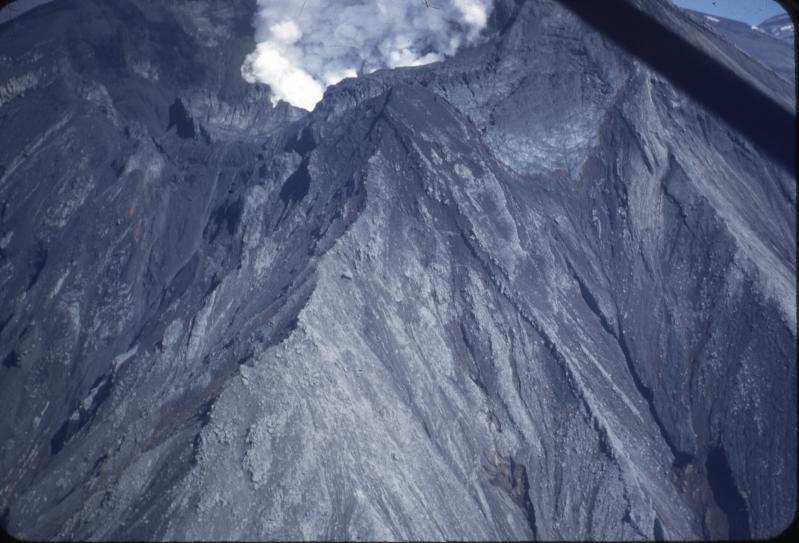
Steam plume rising from the Crater Peak vent on Mt. Spurr volcano. Photo taken on morning of July 11, 1953, following the July 9 eruption that dropped 6 mm of ash on Anchorage. The volcano is heavily coated in ash.
Volcano(es): Spurr
Photographer: Wellenstein, Wallace
URL: avo.alaska.edu/image/view/77441
Crater Peak 1953/7
Initial newspaper accounts of this eruption exclaim "City blacked out by 3 volcanoes!" in large bold type, but in reality, only one volcano, Mt. Spurr, was actually erupting. "Mt. Torbert," as well as the third "unnamed volcano" are not volcanic, and were not erupting. Precursory activity to this eruption may have been observed in mid-May, 1953, when Northern Consolidated Airline pilots reported increased steaming from the summit of Spurr (Unknown, 1953; Fairbanks News-Miner, May 21, 1953).
From Waythomas and Nye (2002): "The first known historical eruption of Crater Peak occurred at about 5 a.m. on July 9, 1953 (Juhle and Coulter, 1955; Miller and others, 1998). For at least 30 years prior to the 1953 eruption, plumes of whitish steam commonly were observed rising from the summit of Crater Peak;" [Note: Although Waythomas and Nye report steaming from Crater Peak, newspaper accounts and pilot observations of the area state that the steaming came from the summit of Spurr.] Waythomas and Nye continue: "pilots reported an increase in the vigor of steaming in late spring 1953 (Juhle and Coulter, 1955). At the time of the 1953 eruption, instruments to monitor the seismic activity were not available. The 1953 eruption was a single explosive burst lasting about one hour, and it generated an ash cloud that rose more than 10,000 meters above sea level (Juhle and Coulter, 1955). Ash fall occurred east of the volcano [see fig. 6 in original text] and approximately 6 millimeters of ash accumulated in Anchorage. A light dusting of ash was reported as far away as Valdez and as close as 48 km to Cordova (Juhle and Coulter, 1955). Pyroclastic flows mixed with snow and ice high on the crater rim and combined with heavy rainfall to produce lahars that inundated tributaries to the Chakachatna River on the south flank of Crater Peak. The lahars flowed into the Chakachatna River and formed a substantial debris dam across the river (Juhle and Coulter, 1955; Meyer and Trabant, 1995)."
A second tephra cloud formed on July 10, 1953, according to Wilcox (1959). "On July 10 at 5:00 am the vent was only steaming. At 3:30 pm an especially strong surge of ash-laden steam rose to 20,000 feet." Juhle and Coulter (1955) state that the eruption continued with steam and small bursts of ash from July 11 to July 16, 1953.
Ash began to fall in Anchorage at about noon on July 9, 1953, and darkened the sky from 1 p.m. until about 3 p.m. (Wilcox, 1953; Juhle and Coulter, 1955; Wilcox, 1959). This ashfall disrupted traffic for two days at Elmendorf Air Force Base and Anchorage International Airport. Three jet aircraft that were sent to investigate the ash plume returned with sandblasted wing leading edges, windshields, side panels, and front portions of their canopies. Elmendorf Air Force Base was closed to air traffic from July 9 -17 due to the eruption (Kienle, 1994). See Wilcox (1959) for detailed pilot descriptions of the ash cloud.
Please cite the photographer when using this image.
Full Resolution.